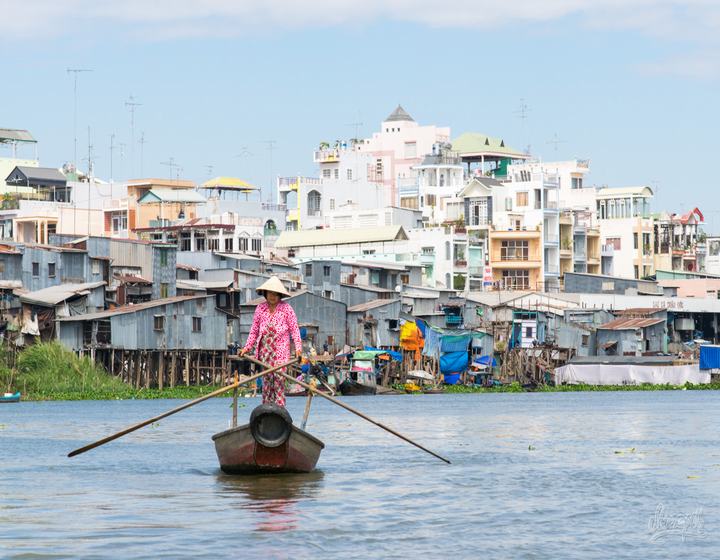
A cruise on the Chau Doc River in Vietnam’s Mekong Delta captivates for a host of reasons including an encounter with the Cham people in floating villages.
Huynh Dang Khoa, 36, a local business manager, likes to take his guests and friends to watch the sun rise on Chau Doc River in An Giang Province and to engage in a bit of cultural exploration.
He loves this particular cruise that takes visitors to famous tourist destinations in An Giang’s Chau Doc area which borders Cambodia, including Sam Mountain, Ba Chua Xu Temple, Tra Su cajuput forest and Tinh Bien Market.
The three-hour tour starts at around 6 a.m. with the experience of watching the sun come up and glisten red over the river’s waters. This is an ideal time for the trip to begin. A late start can prove to be a tad hot, with the sunlight having reached scorching proportions.
Visitors can depart from the marina around the Chau Doc junction or take a cruise ship at the Chau Giang ferry to start a trip to remember.
 |
|
Visitors can opt for traditional wooden boats of locals for a river tour. Photo courtesy of Huynh Dang Khoa. |
The first destination is usually Khanh Hoa Islet, a vantage point to watch the sunrise. The islet stands in the middle of an upstream section of Hau River, bordering Cambodia.
Visitors can also see people fishing in the morning mist. A frequent customer of the cruise, Khoa recommends that his friends take a lot of pictures at the islet. After the flooding season, it gets covered with trees and crops.
The next stop is the floating market on Hau River. Visitors have remarked that this market is less noisy and crowded than the famous Cai Rang floating market in Can Tho City.
Visitors do not have to leave their boat to enjoy their morning coffee or even a hearty breakfast of tasty dishes on offer: fish noodle soup, pig’s offal rice porridge, broken rice with ribs and sweet sticky rice.
Khoa likes to listen to people telling visitors about the structure, paintings and stories about local boats.
The Chau Doc floating village, upstream of the Mekong River, is several kilometers long. People here have lived and farmed fish here since the 60s, at least.
Here, the local stories are even more plentiful – about livelihoods, rafts and natural freshwater fish farming. Manually feeding hundreds of fish below the floor of a house is a popular activity among visitors.
Watching locals fish is another highlight of the cruise. The people here catch fish by bundling dry branches soaked in water, surrounded by nets. Many of Khoa’s guests are surprised and excited to watch the fisherfolk in action.
 |
|
Quaint houses in the Chau Doc floating village. Photo courtesy of Huynh Dang Khoa. |
As the last stop, the boat will take guests to Da Phuoc Village which is over 100 years old. Of more than 10 Cham ethnic villages in the Mekong Delta province, Da Phuoc is one of the few that still retains its pristine, idyllic look, with many original stilt houses still standing.
The village has several mosques, eateries, coffee shops and markets that can be visited from 7 to 10 every morning.
This stop is a cultural highlight. Locals wear colorful sarongs and wrap their heads with big scarves. The market sells many specialties that guests can enjoy on the spot or take away, including fish noodle soup, Cambodian tea, banana cake and river fish.
The Cham people in An Giang are famous for their hand-woven brocade products. Visitors can go to local houses and see Cham women working on looms.
They are also willing to let visitors try their hand at operating the loom, patiently and smilingly explaining the steps. Brocade is a major source of income for the Cham people.
 |
|
At Cham villages, souvenirs such as towels, bags and wallets are available for a few dollars each. Photo courtesy of Huynh Dang Khoa. |
The local mosques with their peaceful ambiance are another popular attraction here.
Since the road in Da Phuoc Village is quite small and short, a leisurely walk will acquaint visitors with the daily life of villagers and they can also try out the local cuisine.
“I hope that in the future, the locality will have a tram service to certain sights here so that it becomes easier for visitors to enjoy their trip,” Khoa said.
At the end of the trip, the passenger boat returns to the station behind Chau Doc Market. Tourists can stop at the salted, dried fish market and shop, have the Vietnamese sandwich with beef sausage and enjoy a cold glass of palmyra water before proceeding further.
The visitor can take the tour to the Chau Doc floating village or do it on his or her own. The tour package includes drinks, snacks and a tour guide who can communicate in English. It will take visitors to three destinations: the floating market, raft village and a Cham village. The tour costs from VND250,000 ($11) to VND1 million depending on the number of passengers. Each boat can carry about 10 people.
A visitor not going on the tour can negotiate with the boat owner to stop at several points along the way, but they often do not provide detailed information about the destination. The price for a ride is VND250,000-300,000 per person. All boats are equipped with life jackets.
From Ho Chi Minh City, tourists can take a night bus for VND150,000-300,000 for a one-way ticket to Chau Doc. It arrives at 5 a.m. the next morning.
